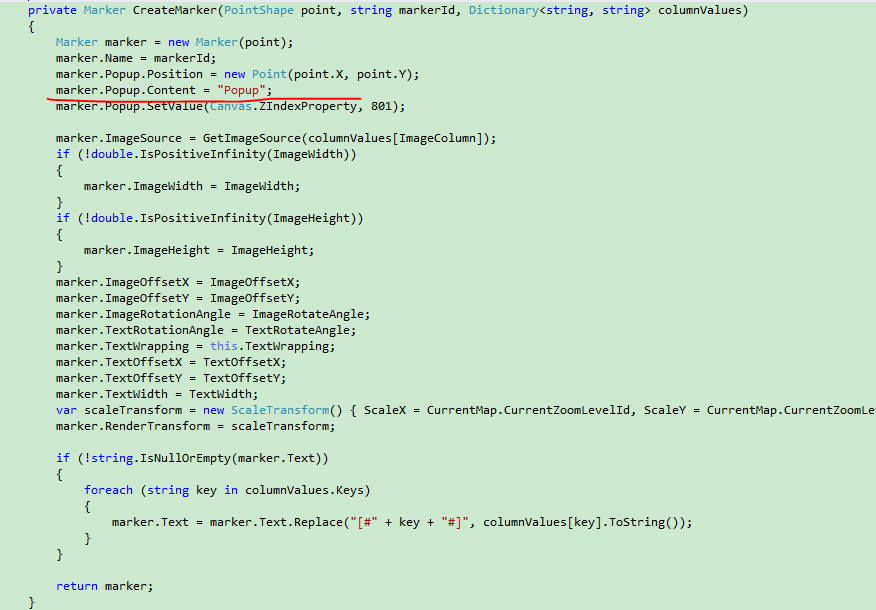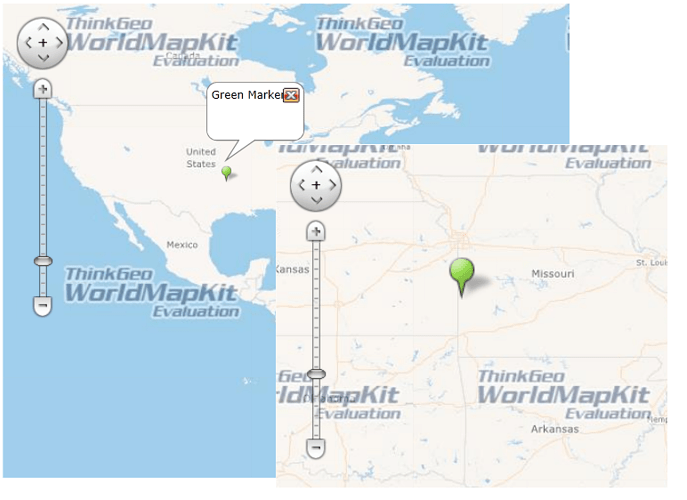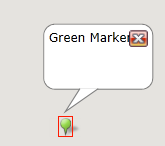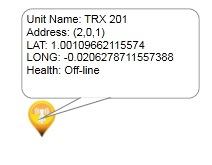[quote=“Peter, post:13, topic:8091”]The SimpleMarkerOverlay is the sample way to display the markers, but we can create a class derived from it and override the GetDrawingMarkersCore method to achieve the requirements.
[/quote] If that is feasible, please show me an example I can use. From what I have seen in the ScalingImageStyle sample, we would have to add a ZoomLevelSet and all its connections. That is much more than just overriding the one method you mention. Extending SimpleMarkerOverlay would be my preferred approach since it already provides all the other functions I need, but adding ZoomLevelSet seems to be very formidable.
[quote=“Peter, post:13, topic:8091”]The sample Don provided before is based on the Service Edition and in Silverlight Edition the MarkerStyle must be a subclass of MarkerStyle. And we can do the similar thing as scaling style to change the marker size like the sample I provided.[/quote] That information helps clear a lot of my confusion! Are you saying that I should not be trying to use ScalingImageStyle? If that approach can be used with your CustomMarkerStyle, please show me.
[quote=“Peter, post:13, topic:8091”]please try the set the popup when create the marker as below[/quote] Making that change (and the related one in MainPage that you did not mention) causes the InMemoryMarkerOverlay.MouseEnter event to work, even though I can see now why I would not need it. However, the popup still does not appear. (Did you test this example?) The Marker.MouseEnter event is raised, but I do not know what to use in that handler to show the popup. The method we use in the Markers collection of SimpleMarkerOverlay is not available (since we have no Marker collection in InMemoryMarkerOverlay) and you don’t show me what to use instead.
[quote=“Peter, post:13, topic:8091”]
It’s not the only way to use the ScaleTransform to change the size of markers, we can also change the markers size when create the markers.
[/quote] I have learned some idea how this might be done. I was surprised to realize that the Markers in InMemoryMarkerOverlay are transient; you recreate every visible Marker every time any Marker event occurs. I did not expect that since the Markers in SimpleMarkerOverlay are persistent, and I am concerned about the performance when I have a large number of Markers visible. It also raises another question for me. My Marker images need to change in response to external events that are related to the associated Feature. How do I cause the Marker to be redrawn with its new image when no marker event has occurred?
[quote=“Peter, post:13, topic:8091”]I don’t understand what the “MouseEnter event for the Marker in InMemoryMarkerOverlay is much larger than I expected” means. Could you please provide more information?[/quote] I found the cause for this. It was the large empty space in the marker images. I replaced them with my images and the bounding rectangle for the MouseEnter event is now what I expected.
Your answers still assume that I understand the Map Suite architecture much better than I do. The purpose of the documentation is to give me that understanding, but yours does not and I have to ask you to teach me instead. I am still a beginner. Please treat me like a beginner. I can learn fast, but only if you give me the information to learn.



 That is what I needed! Thank you, I think I can find my way from here. Only three questions remain:
That is what I needed! Thank you, I think I can find my way from here. Only three questions remain:
 However, it does suggest an idea: Could the disappearing happen because the mouse position is considered to have entered the popup and, therefore, left the marker even though it is still within the marker bounds? If so, a MouseLeave handler for the Marker could check to see if the mouse location has actually left the Marker’s area. If that is possible, how would I control whether the popup remains displayed or closes?
However, it does suggest an idea: Could the disappearing happen because the mouse position is considered to have entered the popup and, therefore, left the marker even though it is still within the marker bounds? If so, a MouseLeave handler for the Marker could check to see if the mouse location has actually left the Marker’s area. If that is possible, how would I control whether the popup remains displayed or closes?

